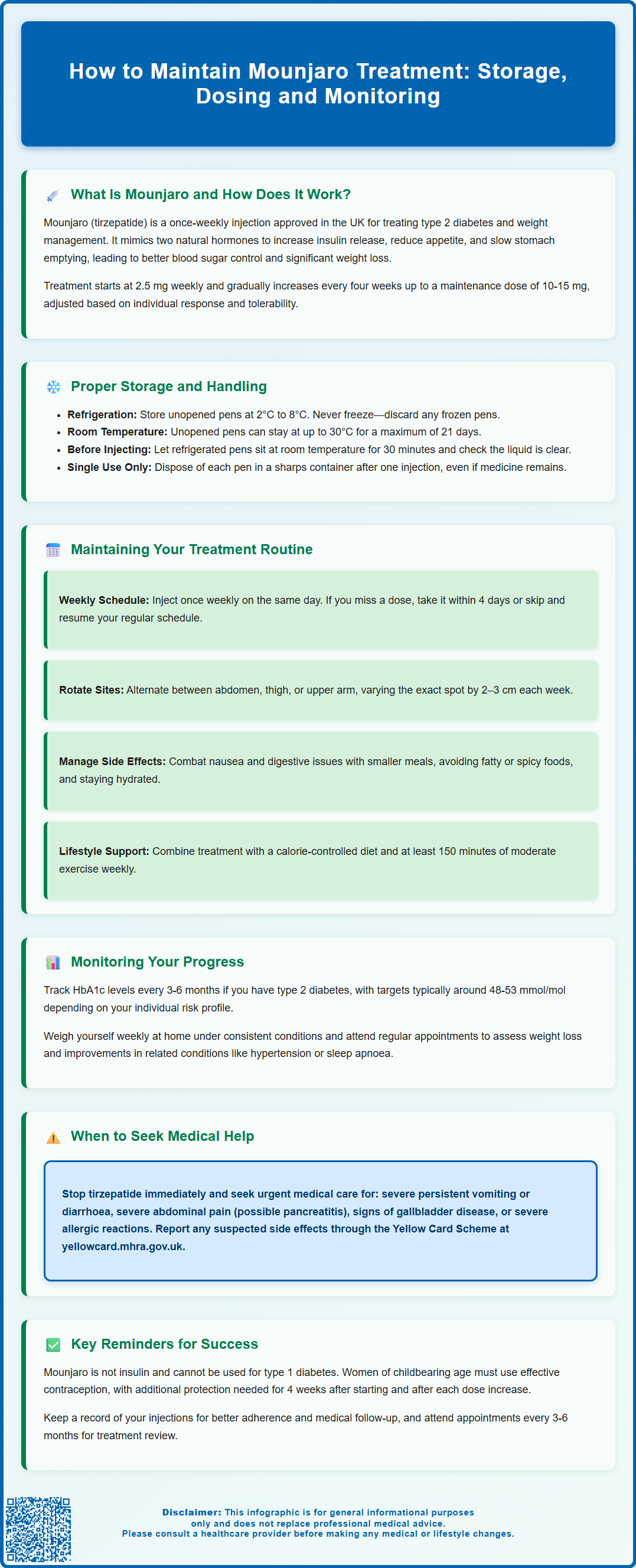Wegovy®
A weekly GLP-1 treatment proven to reduce hunger and support meaningful, long-term fat loss.
- ~16.9% average body weight loss
- Boosts metabolic & cardiovascular health
- Proven, long-established safety profile
- Weekly injection, easy to use

Mounjaro (tirzepatide) is a once-weekly injectable medicine licensed in the UK for type 2 diabetes and weight management in eligible adults. Maintaining effective treatment with Mounjaro involves more than simply administering your weekly injection—it requires proper storage and handling of pens, consistent dosing routines, rotation of injection sites, and regular clinical monitoring. This article provides practical guidance on how to maintain your Mounjaro therapy safely and effectively, including storage requirements, injection technique, managing side effects, and monitoring your progress in line with NHS and NICE recommendations.
Summary: Maintaining Mounjaro treatment involves weekly injections on the same day, proper refrigerated storage at 2–8°C, rotating injection sites, monitoring for side effects, and regular clinical follow-up every 3–6 months.
Mounjaro (tirzepatide) is a prescription medicine licensed in the UK for the treatment of type 2 diabetes. Tirzepatide is also licensed for weight management in adults with obesity or overweight with weight-related comorbidities, though this may be marketed under a different brand name. It is administered as a once-weekly subcutaneous injection using a pre-filled, single-use pen device. Mounjaro belongs to a novel class of medicines known as dual glucose-dependent insulinotropic polypeptide (GIP) and glucagon-like peptide-1 (GLP-1) receptor agonists.
The mechanism of action involves mimicking two naturally occurring incretin hormones that regulate blood glucose and appetite. By activating both GIP and GLP-1 receptors, tirzepatide enhances insulin secretion in response to meals, suppresses glucagon release (which reduces glucose production by the liver), slows gastric emptying, and promotes satiety. This dual action results in improved glycaemic control and significant weight reduction in clinical trials.
Mounjaro is available in several dose strengths—2.5 mg, 5 mg, 7.5 mg, 10 mg, 12.5 mg, and 15 mg—allowing for gradual dose escalation to minimise gastrointestinal side effects. Treatment typically begins at 2.5 mg once weekly for four weeks, then increases every four weeks as tolerated. The maintenance dose is individualised based on clinical response and tolerability, with many patients reaching effective control at 10 mg or 15 mg weekly.
It is important to note that Mounjaro is not insulin and should not be used in people with type 1 diabetes or diabetic ketoacidosis. Caution is advised in patients with a history of pancreatitis. Women of childbearing potential should use effective contraception while taking tirzepatide, and non-oral or additional barrier contraception is recommended for 4 weeks after starting treatment and for 4 weeks after each dose increase. Tirzepatide is not recommended during pregnancy or breastfeeding. The medicine should be used as part of a comprehensive treatment plan that includes dietary modification, physical activity, and regular clinical monitoring.

Correct storage and handling of Mounjaro pens are essential to maintain the medicine's efficacy and safety. Unopened pens should be stored in a refrigerator at 2°C to 8°C and kept in the original carton to protect from light. Do not freeze Mounjaro; if a pen has been frozen, it must be discarded, as freezing can damage the active ingredient and render the medicine ineffective.
If needed, an unopened Mounjaro pen may be kept at room temperature (up to 30°C) for up to 21 days before use. Always check the expiry date printed on the pen label and carton—never use an expired pen.
Handling precautions include inspecting the medicine before each use. The solution should be clear and colourless to slightly yellow. Do not use the pen if the liquid appears cloudy, discoloured, or contains particles, or if the pen is damaged or has been dropped.
When preparing for injection, allow the refrigerated pen to reach room temperature by leaving it out for approximately 30 minutes before use. This can reduce injection site discomfort. Remove the cap immediately before injection. Important: Mounjaro pens are for single use only and should be disposed of after one injection, even if there is medicine remaining in the pen.
Never share your Mounjaro pen with another person, even if the needle is changed, as this poses a risk of infection transmission. Dispose of used pens safely in a sharps container, which can be obtained from your GP surgery or pharmacy. Follow local NHS guidance for sharps disposal, and never throw used pens in household waste.
If travelling, consider using an insulated cool bag to maintain appropriate temperature, but ensure the pen does not come into direct contact with ice or freezer packs. Do not use external heat sources to warm the pen.
Maintaining a consistent treatment routine with Mounjaro is crucial for achieving optimal therapeutic outcomes. Administer your injection once weekly on the same day each week to establish a reliable pattern. You may choose any day that suits your schedule—many patients find it helpful to link their injection day to a regular weekly activity as a memory aid. If you miss a dose, take it as soon as possible within 4 days after the missed dose. If more than 4 days have passed, skip the missed dose and administer the next dose on the regularly scheduled day.
Mounjaro can be injected subcutaneously into the abdomen, thigh, or upper arm. Rotate injection sites each week to reduce the risk of injection site reactions such as redness, itching, or discomfort. For example, if you inject into your abdomen one week, use your thigh the following week. Within each area, vary the exact spot by at least 2–3 cm from the previous injection.
Common adverse effects include nausea, vomiting, diarrhoea, constipation, abdominal pain, and reduced appetite, particularly during dose escalation. These gastrointestinal symptoms typically improve over time. To minimise discomfort, eat smaller, more frequent meals, avoid high-fat or spicy foods, and stay well hydrated. If side effects are severe or persistent, contact your GP or diabetes specialist nurse—your dose escalation schedule may need to be delayed or adjusted.
If you are also taking insulin or sulfonylurea medications, your doctor may reduce these doses to lower the risk of hypoglycaemia (low blood sugar) when starting Mounjaro.
Mounjaro should be used alongside lifestyle modifications, including a balanced, calorie-controlled diet and regular physical activity (NICE recommends at least 150 minutes of moderate-intensity exercise weekly). Keep a record of your injections, including the date, dose, and injection site, either in a diary or using a smartphone app. This helps ensure adherence and provides useful information for your healthcare team during follow-up appointments.
Regular monitoring is essential to assess treatment efficacy, detect adverse effects, and adjust therapy as needed. For patients with type 2 diabetes, your GP or diabetes team will monitor HbA1c (glycated haemoglobin) levels, typically every 3–6 months. HbA1c reflects average blood glucose control over the preceding 8–12 weeks; NICE guidance suggests individualised targets, often around 48 mmol/mol (6.5%) for those not at risk of hypoglycaemia, or 53 mmol/mol (7.0%) for those taking medications that can cause hypoglycaemia.
If you are using tirzepatide primarily for weight management, your healthcare professional will track body weight and body mass index (BMI) at regular intervals. Your clinician will follow NICE guidance regarding continuation criteria, which typically involves achieving a specific percentage of weight loss within a defined timeframe. They will also assess improvements in weight-related comorbidities such as hypertension, dyslipidaemia, obstructive sleep apnoea, or non-alcoholic fatty liver disease.
Self-monitoring at home can be valuable. If you have diabetes, your healthcare team may recommend periodic blood glucose monitoring, particularly if you are taking other glucose-lowering medicines that increase hypoglycaemia risk (such as sulphonylureas or insulin). Weigh yourself regularly—ideally weekly, at the same time of day and under similar conditions—to track progress. Keep a record of any side effects, dietary changes, and physical activity levels to discuss during consultations.
When to seek medical advice: Contact your GP or diabetes specialist nurse immediately if you experience severe or persistent vomiting or diarrhoea (which may lead to dehydration and acute kidney injury), severe abdominal pain (which could indicate pancreatitis), or signs of gallbladder disease (such as pain in the upper right abdomen, fever, or yellowing of the skin/eyes). If you develop symptoms of thyroid disease (such as a lump in the neck, hoarseness, or difficulty swallowing), seek prompt medical review. If you have diabetic retinopathy, report any visual changes promptly and attend regular eye screening appointments. Stop taking tirzepatide and seek urgent medical attention if you suspect pancreatitis or have a severe allergic reaction.
Report any suspected side effects to the Yellow Card Scheme at yellowcard.mhra.gov.uk or via the Yellow Card app. Regular follow-up appointments—typically every 3–6 months—allow your healthcare team to review your progress, adjust treatment, and provide ongoing support for lifestyle modification.
Store unopened Mounjaro pens in a refrigerator at 2–8°C in the original carton to protect from light. Never freeze the pens. Unopened pens may be kept at room temperature (up to 30°C) for up to 21 days if needed.
If you miss a dose, take it as soon as possible within 4 days after the missed dose. If more than 4 days have passed, skip the missed dose and administer the next dose on your regularly scheduled day.
Regular follow-up appointments are typically scheduled every 3–6 months to monitor HbA1c levels for diabetes patients, track weight and BMI for weight management, assess side effects, and adjust treatment as needed.
The health-related content published on this site is based on credible scientific sources and is periodically reviewed to ensure accuracy and relevance. Although we aim to reflect the most current medical knowledge, the material is meant for general education and awareness only.
The information on this site is not a substitute for professional medical advice. For any health concerns, please speak with a qualified medical professional. By using this information, you acknowledge responsibility for any decisions made and understand we are not liable for any consequences that may result.
Lorem ipsum dolor sit amet, consectetur adipiscing elit, sed do eiusmod tempor incididunt ut labore et dolore magna aliqua. Ut enim ad minim veniam, quis nostrud exercitation ullamco laboris nisi ut aliquip ex ea commodo consequat. Duis aute irure dolor in reprehenderit in voluptate velit esse cillum dolore eu fugiat nulla pariatur.
Block quote
Ordered list
Unordered list
Bold text
Emphasis
Superscript
Subscript